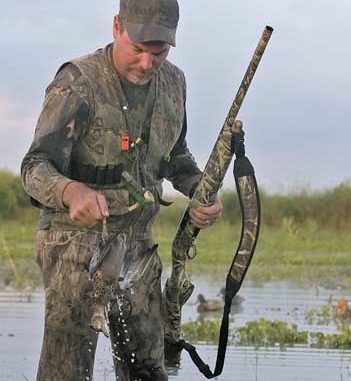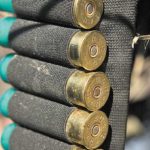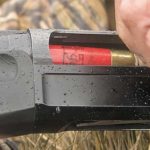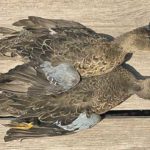
Put these 10 teal tips to work, and you’ll be enjoying bacon, eggs and pancakes while the sun’s still yawning.
“How hard could this be?” I asked myself as my eyes darted from one flock of teal to another. “Don’t know about the rest off these guys, but I’ll be heading back for breakfast before there’s even the slightest sliver of sky between the sun and the horizon.” I readied my reliable Remington 870 Express as the minute hand on my watch crept closer and closer to shooting time. The number of birds in the air seemed to increase as the second hand made its final few ticks.
“Just about time,” said Dennis Tietje, who was buried in tall grass beside me on the levee. “Dad, you ready? Everybody else ready?”
A distant shot rang out from the farm to the west of Tietje’s rice fields in Roanoke.
“Let’s give them just a few more seconds, boys,” Tietje responded to the retort. “Don’t want to jump the gun just because somebody else shot early. We want to make sure we’re legal.”
At the sound of Tietje’s command to shoot, I lifted my gun and pointed it straight up in the sky. Teal were seemingly buzzing into the rice field from every direction at once. They were flying in front of us. They were flying behind us. They were flying between us.
It was almost as if all you had to do to kill a teal was shoot up there amongst them. They were so thick that something had to fall. But fall they did not — at least from my gun.
The seemingly simple task off shooting a bird that was only 20 feet in front of you with a shell full of hundreds of pellets wasn’t so simple. Maybe there was more to this teal hunting thing than what had met my eye.
Our teal count quickly grew to the point that we could not shoot any more, but the only reason I was back for breakfast before the sun completely rose was because of the experience of the hunters around me. It’s been the same way ever since.
With teal season opening this month, I wanted to impress my hunting buddies this year with just how much I had improved as a duck hunter. I found three expert teal hunters who spend every day of every teal season in the blind with customers who have paid to take them hunting.
Jeff Poe, David Faul and Mike Smith have seen it all. They have been in the blind with hunters who killed four teal with four shells, and they have been in the blind with hunters who killed four teal with four boxes of shells.
If you would rather be in the former group than the latter this season, it would serve you well to listen to what these three have to say. Their customers have become better hunters with each friendly tip they’ve passed along. Now you, too, can beat everybody to breakfast by following these top 10 teal tips.
1. Cover rather than conceal
Poe, who operates Big Lake Guide Service on Calcasieu Lake, finds himself hunting more often in denim jeans and a brown T-shirt than completely covered in camouflage clothing.
“During teal season, you don’t have to worry as much about the ducks seeing you,” he said. “Teal are low fliers, and they don’t get as good a look down in your blind as the big ducks do later in the year.”
And although Poe keeps his blinds covered very well during teal season, he says hunters don’t need elaborate blinds this time of year. Just a little bit of covering will suffice, and hunters without blinds will find that crouching down in some brush or tall grass will provide all the cover they need.
“As long as you’ve got something in front of your face and you keep still, you shouldn’t have any problems with teal flaring off because they’re spotting you before you get a chance to shoot,” he said.
2. Hunt shallow fresh water
Whether hunting broken marsh or rice fields, Smith, the five-time Louisiana state duck calling champion who operates Louisiana Marsh Guide Service in the coastal marshes around Reggio and Delacroix, says that setting up in the shallowest water an area has to offer is the right thing to do if you want to shoot more birds.
“It doesn’t matter if you’re on a lease or public land,” he said. “Teal really like shallow water because they have an easier time feeding in it. Obviously, they don’t dive for food, so whatever they are eating — grasses, seed and stuff — has to be near the surface. That way they can get what they need by just dabbling around.”
In the marshes that Smith hunts, he likes to not only find shallow water, but fresh water as well. He explained that the Carnarvon area holds lots of teal because of the fresh water released through the diversion system.
“You can get by with having some salinity with ducks like gadwall, but not so much the teal,” Smith said. “A lot of this area is locked up in leases, but if you find the same combination on your own lease or wherever you hunt, you’ll find more birds.”
3. Hunt broken marsh
Teal love to eat the little wild millet seeds that float around on the surface in areas of what Smith called broken marsh. An area like the south side of Lake Lery, which is totally leased up by the way, is a perfect example of what Smith is talking about.
“Where you see all that widgeon grass and coontail, those big areas are mainly grey duck and widgeon territories,” Smith said. “You won’t find teal rafting up in big lagoons like the big ducks do. They like to stay back in areas that have a good mix of marsh and water.”
While most of the marsh on the east side of the river is locked up in leases, Smith said hunters can find exactly what they’re looking for at Biloxi WMA. Before Katrina, it was one of the best teal spots in the area, and Smith suggested looking for birds around the Bayou Biloxi area.
4. Learn the lead
Having seen several hunters struggle to connect with the teal at which they were shooting, Faul, owner of Bin There Hunting in Welsh, says the main reason many hunters miss is because they aren’t leading them nearly enough.
“This is something I’ve tried to help correct while on a hunt,” said Faul. “It’s always tough to get inexperienced shooters to visualize what their lead should looks like while looking down the barrel of a shotgun.”
Faul tells his hunters to try to get about 3 feet in front of the birds, but many take the advice to mean 3 feet of air space between the end of their barrel and the teal. The trick is to understand that a 3-foot lead in front of the bird looks more like 1 or 2 inches at the end of the barrel.
“It’s hard to understand that 3 feet is at the point of contact and not at the gun,” Faul said. “It’s such a second-nature kind of instinct once you get used to it, but I try to tell them to get about 2 inches in front of the bird.”
5. Swing through
Besides getting his hunters to learn what the right lead looks like, Faul also advises them to keep swinging their guns rather than stopping them 2 inches in front of the bird to pull the trigger.
“Don’t stop swinging,” he said. “If you pull up and stop on a bird that’s flying 80 m.p.h., you’re going to be so far behind it that you won’t even ruffle its tail feathers. I like a light shotgun exactly for this reason. I’m sure it’s personal preference, but I can swing a light gun a lot easier than I can a heavy one.”
The importance of following through when shooting a teal is the same as following through with any other athletic sports motion. Imagine if you would a batter stopping his swing as soon as he hit a baseball. Stopping would totally throw off the batter’s mechanics, and the ball would be hit weakly at best.
“The same thing happens if you don’t swing through on your shot,” Faul said. “Get used to swinging through with a full motion, and you’ll kill a lot more teal.”
6. Lighten up a little
“I get a lot of customers who come out teal hunting with 3 1/2-inch shells and tight chokes,” said Smith. “They’re geared up exactly like they would be during big duck season, but that’s definitely not required. In fact, it’s kind of like taking a bazooka on a squirrel hunt.”
Most teal shots are within about 20 yards, and Smith says hunters will be more successful shooting small shot like No. 6 and improved-cylinder chokes. If he can’t find the No. 6 shot, Smith will go with No. 4. But he added that No. 6 in the Kent brand is usually easy to find.
“Teal hunting is almost like dove hunting,” Smith said. “The birds are thin-skinned, and they don’t have their thick winter plumage yet. During September, they’re actually still in what’s called eclipse summer plumage. You don’t have to worry about your 6-shot bouncing off the ducks.”
7. Shoot a faster shell
Using No. 6 shot means hunters are throwing more BBs out there than they would be with 4s or 2s. However, No. 6 steel shot doesn’t have much impact force out there where the teal fly. Faul has learned that shooting a faster load leads to more birds in the bag.
“Steal doesn’t have the knock-down power that lead does,” he said. “But if you can get the speed of steel shot up, it has a better penetration at the point off contact. Rather than looking at load charge, I recommend looking at the feet-per-second rating.”
But shooting a faster shell means hunters need to put in more time shooting skeet, and Faul was adamant that hunters shoot skeet with the same shell they are going to use during a teal hunt.
“If you’re shooting skeet with some 800 f.p.s. target loads, you won’t have a clue where your shooting if you change to a 1,450 f.p.s. No. 6 shot in the field,” Faul said. “And crank up the speed on the thrower as fast as you can because teal are fast fliers.”
8. Use hen decoys
Knowing that most of the teal that will fly past his blind this September are bluewings that are still in their summer plumage, Poe sticks with tossing out only hen decoys during the special early season.
“It wouldn’t look very natural to have a bunch of drake decoys out, whether they’re mallard, teal or whatever,” he said. “If all the ducks in the area are dull and brown, you’ll attract a lot more birds if your decoys look the same way.”
While some may argue that larger decoys like mallards would attract more birds from a distance, the important thing to remember is that it doesn’t really matter what kind of decoy you use as long as you use the duller hen versions.
“And you don’t have to throw a bunch of them out,” Poe said. “If you’re in an area that’s holding ducks, you can get by with about a dozen or so decoys. Teal like to sit down around other birds, so having some out is important, but like the guns and shot, more isn’t always better.”
9. Carry your calls
While standing on a levee in Southwest Louisiana where the teal are literally as thick as the mosquitoes, it might be difficult to understand the importance of having the two primary styles of teal calls.
“In my experience, I would say that calling at teal that are passing over your pond will make them turn around on a dime and come back to you about six times out of 10,” said Smith. “The two to have are the high-pitched hen call like what Haydel and Duck Commander make and the peep-peep call, which is a drake call.”
Smith recommended that hunters hit passing teal with the hen call to try to get them to turn around if it looks like they are heading someplace else. Once the birds show some interest, then it might be helpful to have another hunter make a few peeps on the drake call.
10. Hunt the weekends
Anybody who hunts or fishes in Louisiana knows that the number of participants in each increases dramatically when the weekend comes. While many hunters may take a vacation day to try to hunt during the week when there is less pressure, Smith says the weekend is often the best time to be in a teal blind.
“I remember hunting on a Tuesday, Wednesday and Thursday a season or two ago,” Smith recalled “We were having successful hunts, but they were a lot harder than what they should have been. We had very few shots.
“When the weekend came that same week, it was like they just came out of the woodwork. All those extra hunters kept the birds stirred up and moving around, and that meant we had a lot more action, and we got our birds a lot quicker than we had otherwise.”
If you think you’re already a master of all these teal techniques, just remember that pride always comes before the fall. Just when you think you can’t learn any more, a teal will buzz your blind and make a buffoon out of you.
Beating everybody back for breakfast might be your goal, but it won’t happen if you aren’t ready for opening morning. Put these tips to work for you this teal season, and you’ll find yourself first at the buffet line.
Contact Jeff Poe at 337-598-3268 or www.biglakeguideservice.com, David Faul at 888-507-9288 or www.bintherehunting.com and Mike Smith at 504-228-4506 or www.laduckhunts.com.







